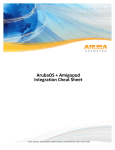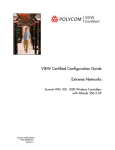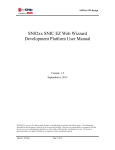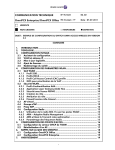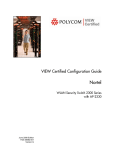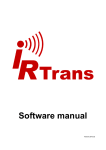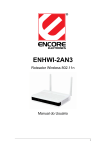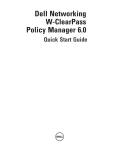Download Polycom A200 User's Manual
Transcript
VIEW Certified Configuration Guide Aruba Mobility Controllers A200, A800, A2400, A6000 June 2008 Edition 1725-36080-001 Revision J Configuration Guide Trademark Information Notice Polycom® and the logo designs SpectraLink® LinkPlus Link NetLink SVP Are trademarks and registered trademarks of Polycom, Inc. in the United States of America and various countries. All other trademarks used herein are the property of their respective owners. Polycom, Inc. has prepared this document for use by Polycom personnel and customers. The drawings and specifications contained herein are the property of Polycom and shall be neither reproduced in whole or in part without the prior written approval of Polycom, nor be implied to grant any license to make, use, or sell equipment manufactured in accordance herewith. Patent Information The accompanying product is protected by one or more US and foreign patents and/or pending patent applications held by Polycom, Inc. Copyright Notice Copyright © 2006 to 2008 Polycom, Inc. All rights reserved under the International and pan-American copyright Conventions. No part of this manual, or the software described herein, may be reproduced or transmitted in any form or by any means, or translated into another language or format, in whole or in part, without the express written permission of Polycom, Inc. Do not remove (or allow any third party to remove) any product identification, copyright or other notices. Polycom reserves the right to make changes in specifications and other information contained in this document without prior notice, and the reader should in all cases consult Polycom to determine whether any such changes have been made. No representation or other affirmation of fact contained in this document including but not limited to statements regarding capacity, response-time performance, suitability for use, or performance of products described herein shall be deemed to be a warranty by Polycom for any purpose, or give rise to any liability of Polycom whatsoever. Contact Information Please contact your Polycom Authorized Reseller for assistance. Polycom, Inc. 4750 Willow Road, Pleasanton, CA 94588 http://www.polycom.com Every effort has been made to ensure that the information in this document is accurate. Polycom, Inc. is not responsible for printing or clerical errors. Information in this document is subject to change without notice and does not represent a commitment on the part of Polycom, Inc. 2 PN: 1725-36080-001_J.doc Aruba Mobility Controllers: A200, A800, A2400, A6000 Introduction Polycom’s Voice Interoperability for Enterprise Wireless (VIEW) Certification Program is designed to ensure interoperability and high performance between SpectraLink Wireless Telephones and WLAN infrastructure products. The products listed below have been thoroughly tested in Polycom’s lab and have passed VIEW Certification. This document details how to configure the Aruba mobility controller with SpectraLink Wireless Telephones. Certified Product Summary Manufacturer: Aruba Networks http://www.arubanetworks.com Approved products: Controllers Access Points A200 A800 A2400 A6000 † AP41 AP60 AP61 AP65 AP70 † RF technology: 802.11b/g/a Radio: 2.4 GHz (802.11 b/g), 5 GHz (802.11a) Security: WPA2-PSK AP firmware version certified: 2.5.4.0 SpectraLink handset models certified: ** e340/h340/i640 8020/8030 SpectraLink handset software certified: 89.134 122.010 or greater SpectraLink radio mode: 802.11b Maximum telephone calls tested per AP: † 802.11b 802.11g 12 12 802.11a * Network topology: Switched Ethernet (recommended) Denotes products directly used in VIEW Certification testing. * Maximum calls tested during VIEW Certification and the recommended setting in the SpectraLink 8000 SVP Server. The certified product may actually support a higher number of calls for 802.11a and 802.11g radio modes. ** SpectraLink handset models 8020/8030, e340/h340/i640 and their OEM derivates are VIEW Certified with the WLAN hardware and software identified in the table. Throughout the remainder of this document they will be referred to collectively as “SpectraLink Wireless Telephones”. Customer Service If you encounter difficulties or have questions regarding the configuration process, please contact Aruba Networks technical support at 1-800-943-4526, visit www.arubanetworks.com/support or e-mail [email protected]. PN: 1725-36080-001_J.doc 3 Configuration Guide Network Topology It is important to note that this configuration is not necessarily applicable to all customer environments. The following topology was tested during VIEW Certification testing. Known Limitations No limitations were discovered during VIEW Certification testing. VIEW Certification testing verifies that the wireless telephone and the AP interoperate at the packet level; therefore, no add-on vendor features were tested in the scope of VIEW. 4 PN: 1725-36080-001_J.doc Aruba Mobility Controllers: A200, A800, A2400, A6000 Deployment Description It is a SpectraLink requirement that voice users be placed on a separate VLAN (e.g., VLAN 10) and data users on a separate VLAN (e.g., VLAN 25). The voice and data VLANs reside on the Aruba mobility controller and not on the access points (APs). The user traffic is tunneled back to the Aruba controller for processing. The edge network thus does not have to be modified to accommodate the WiFi clients and the VoWiFi network. Map each VLAN to a unique subnet. The mobility controller (switch) IP address needs to be set via the loopback interface setting. The Controller’s loopback address must be a routable address so that the APs can reach this address. Interface setting Identify the mobility controller port that serves as the uplink port for the data VLAN. The physical port used in this example is Fast Ethernet 1/0. This port is configured as a trunk port with both the voice and data VLAN. Default route The L3 switch connected to the Aruba controller serves as the default gateway for all the WiFi clients. Configure the default route to the next-hop gateway connected to the mobility controller. Physical interface All interfaces that connect to the core networks, routers, servers and gateways need to be set as trusted ports. Connecting the APs The APs need an IP address for communication with the mobility controller. The APs can connect to the controller over a L2 or L3 network. Ensure that DHCP is enabled on the subnets the APs are connected to and the APs can ping the Aruba mobility controller’s “switch IP address” from their current subnet. PN: 1725-36080-001_J.doc 5 Configuration Guide Connecting to the Mobility Controller Command, comment, and screen text key In the sections below you will find commands, comments, prompts, system responses, or other screen-displayed information involved in the configuration process. This key explains the text styles and symbols used to denote them. Text Style Denotes: xxxxxxxx Typed command <xxxxxxxx> Encryption key, domain name or other information specific to your system that needs to be entered (xxxxxxxx) Comment about a command or set of commands xxxxxxxx Prompt, system response or other displayed information Via console 1. Using a standard RS-232 cable, connect the Aruba mobility controller to the serial port of a terminal or PC. 2. Run a terminal emulation program (such as HyperTerminal™) or use a VT-100 terminal with the following configuration: Bits per second: Data bits: Parity: Stop bits: Flow control: 9600 8 None 1 None 3. Press Enter to display the Aruba mobility controller login screen. 4. Enter the default login: admin and the default password: admin. These are case sensitive. 5. Enter enable and the default password: admin to get into the command mode. 6 PN: 1725-36080-001_J.doc Aruba Mobility Controllers: A200, A800, A2400, A6000 Via the CLI By default, only SSH (Secure Shell) access to the switch (mobility controller) is permitted. 1. From a management system that has network connectivity to the switch, connect to the switch using SSH: ssh admin@<switch IP address> 2. Enter the admin password at the password prompt. 3. Type enable at the > prompt to enter the enable mode. 4. Type the enable password when prompted for a password. Via the Web interface Once the connectivity to the switch is verified, open a Web browser and enter the switch’s IP address in the navigator bar. The switch can be accessed using http at http://<switch IP Address> or https at https://<switch IP Address>:4343. The user is prompted with the username and password configured (in the example above, the username/password configured is admin/admin). On successful login the following Network Summary screen is displayed: PN: 1725-36080-001_J.doc 7 Configuration Guide Initial Setup Before starting, please ensure that the Policy Enforcement Firewall module license is enabled on the Aruba mobility controller. Please contact Aruba Networks for licenses and installation information. On power-up, the user is presented with the startup wizard: Enter System name [Aruba800]: Aruba Enter VLAN 1 interface IP address [172.16.0.254]: Enter VLAN 1 interface subnet mask [255.255.255.0]: Enter IP Default gateway [none]: Enter Switch Role, (master|local) [master]: master Enter Country code (ISO-3166), <ctrl-I> for supported list: US You have chosen Country code US for United States (yes|no)?: yes Enter Password for admin login (up to 32 chars): admin Re-type Password for admin login: admin Enter Password for enable mode (up to 15 chars): enable Re-type Password for enable mode: enable Do you wish to shutdown all the ports (yes|no)? [no]: no Current choices are: System name: Aruba VLAN 1 interface IP address: 172.16.0.254 VLAN 1 interface subnet mask: 255.255.255.0 IP Default gateway: none Switch Role: master Country code: US Ports shutdown: no If you accept the changes the switch will restart! Type <ctrl-P> to go back and change answer for any question Do you wish to accept the changes (yes|no)yes 8 PN: 1725-36080-001_J.doc Aruba Mobility Controllers: A200, A800, A2400, A6000 . . . . . <<<<< Welcome to Aruba Wireless Networks - Aruba 800 >>>>> . . . . (Aruba) User: PN: 1725-36080-001_J.doc 9 Configuration Guide Assigning an IP to the Mobility Controller 1. Connect to the switch via the CLI. 2. Login with the configured username and password, admin/admin in this example. 3. Type enable at the > prompt. 4. Type the enable password, enable in this example. 5. Type configure terminal at the # prompt. 6. Create the VLAN for the voice (vlan 25) using the VLAN command: (Aruba) (config) #vlan 25 7. Create the VLAN interface. (Aruba) (config) #interface vlan 25 8. Assign the IP address to the interface. (Aruba) (config-subif)#ip address 10.168.10.2 255.255.255.0 9. Create the loopback interface and assign an IP address to the loopback. For more information about the loopback interface refer to the user guide. (Aruba) (config) #interface loopback (Aruba) (config-loop)#ip address 10.168.10.1 Switch IP Address is Modified. Switch should be rebooted now (Aruba) (config-loop)#! (Aruba) (config) #ip default-gateway 10.168.10.10 10. Assign a physical interface to the VLAN. In this example, the interface connecting to the network is a trunk interface. Configure the mode on the interface to a trunk mode. (Aruba) (Aruba) (Aruba) (Aruba) (Aruba) 10,25 (Aruba) (config) #interface fastethernet 1/0 (config-if)#trusted (config-if)#no shutdown (config-if)#switchport mode trunk (config-if)#switchport trunk allowed vlan add (config-if)#! (Aruba) (config)# 11. Ping the default gateway from the switch’s console. 12. Ping the switch’s IP address from the management station. 10 PN: 1725-36080-001_J.doc Aruba Mobility Controllers: A200, A800, A2400, A6000 Connecting APs Provisioning APs The APs need to be provisioned. The Aruba APs can be provisioned manually or be configured for automatic provisioning. For manual provisioning, use the Web-based AP provisioning Web page. Refer to the AP Provisioning User Guide for instructions on provisioning the AP. The APs can communicate with the controller over a L2 or L3 network. The only requirement is that each AP be assigned an IP address and default gateway using DHCP. PN: 1725-36080-001_J.doc 11 Configuration Guide SSID Configuration CLI command configuration APs can be configured using the CLI or the Web interface. Each AP is identified by a unique location code. The APs can either be configured per location with unique settings using the AP’s unique location code or globally using the wildcard location. “0” is used as the wildcard. Example: ap location 0.0.0 will configure all Aruba APs on the WLAN system. Both the Aruba APs and the Spectralink handsets support the 802.11a and the 802.11b/g radios. To apply the SSID to both bands configure the SSID as follows: configure terminal ap location x.y.z virtual-ap aruba vlan-id 26 opmode wpa2-aes-psk wpa-passphrase thisisthekey dtim-period 3 If the voice network needs to exist only in the 802.11a band , configure the virtual AP under the 802.11a settings on the controller. configure terminal ap location x.y.z phy-type a virtual-ap aruba vlan-id 26 opmode wpa2-aespsk wpa-passphrase thisisthekey dtim-period 3 If the voice network needs to exist only in the 802.11g band, configure the virtual AP under the 802.11g settings on the controller. configure terminal ap location x.y.z phy-type g virtual-ap aruba vlan-id 26 opmode wpa2-aespsk wpa-passphrase thisisthekey dtim-period 3 To save changes, enter: write mem 12 PN: 1725-36080-001_J.doc Aruba Mobility Controllers: A200, A800, A2400, A6000 Web-based configuration 1. Click the Configuration button. 2. In the navigation pane, select Network from the WLAN sub-menu. 3. To edit an existing AP profile, click the Edit button corresponding to the SSID. 4. To add a new profile, click the Add button. 5. Under Add SSID, enter aruba in the SSID field. 6. Select 802.11a/b/g from the Radio Type drop-down list to apply the SSID settings to the a/b/g radio. 7. For the SSID Default VLAN, enter the voice VLAN number. 8. For the DTIM Period, enter 3. 9. Select the AES-CCM option for WPA2-AES-PSK encryption. 10. Under WPA2, select the PSK AES-CCM option. 11. Select PSK Passphrase (alphanumeric) from the Format drop-down list before typing in the passphrase. 12. Enter the PSK AES Key/Passphrase. 13. Click the Apply button. Navigating to other pages without saving/applying the changes will result in the loss of the changes. PN: 1725-36080-001_J.doc 13 Configuration Guide Access Point Configuration Radio setting 802.11b or 802.11g When using the 802.11b/g band for the VoWiFi network, set the radio settings to 802.11b/g mixed mode. Preamble settings The tests on the Aruba system were run with the short preamble setting. The short preamble setting can be used, as this supports both short and long preambles. SpectraLink Wireless Telephones only support long preamble when using the 802.11b radio. When using a dual-radio AP, use the 802.11a radio for data and 802.11b/g for voice if possible, as this will improve the overall performance. Channel and Tx power Channel and Tx power level can be manually set or configured to be assigned automatically depending on the RF environment. Please consult your facility’s RF site survey designed for voice to determine the correct channel, power and data rate settings. SpectraLink Wireless Telephones require the following minimum dBm reading to support the corresponding “Required” data rate setting in the access point. 802.11 Radio Standard 802.11b 802.11g 802.11a 14 Minimum Available Signal Strength (RSSI) -70 dBm Maximum "Required" Data Rate 1 Mb/s -60 dBm 11 Mb/s -63 dBm 6 Mb/s -47 dBm 54 Mb/s -60 dBm 6 Mb/s -45 dBm 54 Mb/s PN: 1725-36080-001_J.doc Aruba Mobility Controllers: A200, A800, A2400, A6000 For additional details on RF deployment please see the Deploying Enterprise-Grade Wi-Fi Telephony white paper and the Best Practices Guide for Deploying SpectraLink 8020/8030 Wireless Telephones. Recommended AP configuration settings CLI Commands Required Settings Default Settings 0 Max-clients <x> 40 Beacon-interval <x> Set to default 100 milliseconds The interval at which beacons are sent out . dtim-period <x> 3 1 Delivery Traffic Indication Message interval in terms of beacon interval. hide-essid <enable / disable> Enable Disable To disable the ESSID from being broadcasted. Max-retries 2 4 Maximum number of times the AP tries to send a packet to the client before discarding the packet. b/g-mode Mixed Mixed The radio mode of the b/g radio. Tx-power <0-4> 0 As per the environment. This need not be set if ARM is enabled. Channel <x> 1 This is the channel assigned to the radio. Need not be set if ARM is enabled. 802.11b/g rates These rates should be determined from RF site survey. Verify you have sufficient coverage to support data rates. 5,11 802.11b/g Tx rates These rates should be determined from RF site survey. Verify you have sufficient coverage to support data rates. 1,2,5,11 802.11b/g rates (if all wireless client are 802.11g) These rates should be determined from RF site survey. Verify you have sufficient coverage to support data rates. 5,11 PN: 1725-36080-001_J.doc Description Max clients that can associate with the AP. The supported Tx rates for 802.11b/g. 15 Configuration Guide CLI Commands Required Settings 802.11b/g Tx rates (if all wireless client are 802.11g) These rates should be determined from RF site survey. Verify you have sufficient coverage to support data rates. 802.11a rates These rates should be determined from RF site survey. Verify you have sufficient coverage to support data rates. 6,9,12,24 802.11a Tx rates These rates should be determined from RF site survey. Verify you have sufficient coverage to support data rates. 6,9,12,18,24, 36,48,54 The supported Tx rates for 802.11a. ESSID <voice ssid as configured> Aruba This is the ESSID that the voice devices would associate with. Short preamble Tested: Enable Recommended: Disable Enable Set the short preamble to disable, to enable longpreamble-only support. 16 Default Settings 1,2,5,11 Description PN: 1725-36080-001_J.doc Aruba Mobility Controllers: A200, A800, A2400, A6000 CLI command configuration All of the commands listed in the CLI Commands column above must be entered under the ap location command. The format is: ap location x.y.z phy-type g (To make the changes for the “g” radio.) commands ! phy-type a (To make the changes for the “a” radio.) commands ! Web-based configuration 1. Click the Configuration button. 2. In the navigation pane, select Radio from the WLAN sub-menu. 3. Click the 802.11b/g tab. 4. For Max Retries, enter 2 for voice. 5. Select the Short Preamble check box. 6. For the DTIM period, enter 3. 7. For Basic Rates and Supported Rates, consult the facility’s RF site survey to determine if coverage is sufficient to support all data rates. 8. To assign the power and channel setting manually: a. For ARM Assignment, select Disabled. b. Clear the ARM Scanning check box. c. Set the Default Channel and Initial Transmit Power from their dropdown lists. d. For Mode, click the Access-point option. 9. Click the Apply button. PN: 1725-36080-001_J.doc 17 Configuration Guide 18 PN: 1725-36080-001_J.doc Aruba Mobility Controllers: A200, A800, A2400, A6000 10. Click the 802.11 a tab. 11. For Max Retries, enter 2 for voice. 12. For the DTIM period, enter 3. 13. For Basic Rates and Supported Rates, consult the facilities RF site survey to determine if coverage is sufficient to support all data rates. 14. To assign the power and channel setting manually: a. For ARM Assignment, select Disabled. b. Clear the ARM Scanning check box. c. Set the Default Channel and Initial Transmit Power from their dropdown lists. d. For Mode, click the Access-point option. 15. Click the Apply button. PN: 1725-36080-001_J.doc 19 Configuration Guide Dynamic RF Management — ARM Aware Scanning If Adaptive Radio Resource Management (ARM) Aware Scanning (RF scanning) is included in your firmware release, it can be enabled through the command line interface as follows: configure terminal ap location x.y.z phy-type g arm scanning enable arm assignment single-band arm voip-aware-scan enable phy-type a arm scanning enable arm assignment single-band arm voip-aware-scan enable write mem This feature was enabled during VIEW Certification testing in a screen room (strong signals in a clean environment). A real-world test with interfering RF signals was not simulated. 20 PN: 1725-36080-001_J.doc Aruba Mobility Controllers: A200, A800, A2400, A6000 Security Policies and QoS Once the basic infrastructure is configured, it is necessary to configure the security policies to ensure that the data network and the voice network are secured and access to these networks is limited as required. The steps are as follows: 1. Setup aliases for the SVP Server. 2. Set policies for the wireless telephone user to the required voice server, DHCP and TFTP servers. Add other ACLs as required to permit other traffic from the wireless telephones. 3. Assign policies to the role. Create an alias for the SVP Server 1. Click the Configuration tab. 2. In the navigation pane, select Advanced from the Security sub-menu. 3. Click the Destinations tab. 4. To add a new destination, click the Add button. 5. Create a new net-destination at Destination Name (e.g. svp_server), and add the SVP servers as hosts. For more details on configuring the net-destinations, refer to the user guide. PN: 1725-36080-001_J.doc 21 Configuration Guide Create policies for the wireless telephone user The policies shown in the above example can be configured using the Web interface as follows: 22 PN: 1725-36080-001_J.doc Aruba Mobility Controllers: A200, A800, A2400, A6000 Assign policies to the role Create a role, for example phones, and assign the policies to this role. This is the role that would be assigned to the handsets when they are authenticated successfully. The Security Policies and QoS can also be configured through the command line interface (CLI). The CLI commands corresponding to this section are as follows: configure terminal netdestination tftp-server host 10.168.0.20 ! netdestination svp_server host 10.168.0.11 host 10.168.0.12 ! netdestination dhcp-server host 10.168.0.21 ! ip access-list session phone_acl user user any deny user alias svp_server svc-svp permit queue high PN: 1725-36080-001_J.doc 23 Configuration Guide alias svp_server user svc-svp permit queue high user alias tftp-server svc-tftp permit user alias dhcp-server svc-dhcp permit user host 224.0.1.116 any permit ! user-role phones session-acl phone_acl ! 24 PN: 1725-36080-001_J.doc Aruba Mobility Controllers: A200, A800, A2400, A6000 Authentication In addition to the encryption, Aruba recommends the use of MAC authentication to authenticate the Spectralink handsets. On the Aruba System, the roles for SpectraLink Wireless Telephones are derived using MAC-authentication. The wireless telephones can be authenticated individually using MAC-authentication or as a group using the vendor OUI and derivation rules. For instruction on enabling MAC-authentication refer to Aruba’s user guide. For the OUI based derivation rule, configure the following from the CLI: aaa derivation rules user set role condition macaddr starts-with "00:90:7a" setvalue phone PN: 1725-36080-001_J.doc 25 Configuration Guide Quality of Service (QoS) Quality of service is achieved by prioritizing the SpectraLink voice traffic over data traffic. To prioritize the voice traffic over data traffic in the AP traffic queues, the “queue high” tag is used at the end of each ACL to prioritize the traffic matching the ACL over all other traffic. In the example shown above: user alias svp_server svc-svp permit queue high alias svp_server user svc-svp permit queue high The traffic that matches the above two rules is prioritized over all other traffic. In addition, a DiffServ tag or a Dot1p tag can be configured at the end of each ACL to indicate the relative priority of the traffic to the traffic to the network. Example : user alias svp_server svc-svp permit dot1p 4 queue high dot1p-priority 4 tos 4 queue high alias svp_server user svc-svp permit queue high dot1ppriority 4 tos 4 queue high By default, the packets are not tagged. In addition multicast/bradcast traffic in the air can be limited by turning on the firewall voip-prox-arp. This command is available on the CLI alone. (Aruba)# configuration terminal (Aruba) (config)# firewall voip-proxy-arp 26 PN: 1725-36080-001_J.doc Aruba Mobility Controllers: A200, A800, A2400, A6000 Subnet Roaming The Aruba system can be set up to support inter-switch inter-subnet roaming. The topology is as shown in the figure on page 2. When two or more switches are used in the Aruba WLAN system, one switch has to be identified as the master and the others as the local switch. During VIEW Certification testing, the Aruba 800 was configured as the master switch and the Aruba 6000 was configured as a local switch; therefore, this configuration is used in the following examples. For instructions on setting up a switch as a local switch refer to Aruba’s user guides. Ensure that both switches have IP connectivity. A simple ping from each of the switches to the other switch can be used to verify connectivity. In a master local setup all AP, authentication, and firewall configurations will be made on the master and pushed down to the local switch. In the configuration tested, all APs with location code 1.1.0 were configured to boot off of the master switch and all APs with location code 1.2.0 were configured to boot off of the local switch. To use the Web interface to configure this, do the following: 1. From the master switch, navigate to the Configuration > WLAN > Advanced tab. 2. Add a new location 1.1.0 and click the Apply button. 3. In the next page click the General tab and set the LMSIP to the “switch IP” address of the master. 4. Apply the configurations. 5. Configure location 1.2.0 in a similar manner and set the LMSIP address to the “switch IP” address of the local switch. 6. Create a default route for multicast traffic re-direction on the switch that acts as the Mobility Home Agent for the Voice group (this was done on the master switch in the test example). PN: 1725-36080-001_J.doc 27 Configuration Guide CLI Commands to Set Up Subnet Roaming Commands for the master switch (the Aruba 800) Configure terminal ip default-gateway <ip_addr of router> ap location 1.1.0 (#ap connected to 800) lms-ip <ip_addr of 800 switch> ap location 1.2.0 (#ap connected to 6000) lms-ip <ip_addr of 6000 switch> ip route 224.0.0.0 255.0.0.0 <ip_addr of SpectraLink gateway> exit write mem Commands for the local switch (the Aruba 6000) The AP’s IP address must be on the same subnet as the switch. Configure terminal masterip <ip address of the master > interface loopback ip address <ip_addr of the 6000> vlan 1 interface vlan 1 ip address <ip_addr of the 6000> <netmask> interface fastethernet <port> switchport access vlan 1 (only if the port is an access port) trusted no shut ! ip default-gateway <ip_addr of router> ! exit write mem After the master switch IP address and the local switch IP address are configured on the local switch, the switch needs to be rebooted prior to use. 28 PN: 1725-36080-001_J.doc Aruba Mobility Controllers: A200, A800, A2400, A6000 It’s also necessary to set the default gateway of the SpectraLink 8000 SVP Server and SpectraLink 8000 Telephony Gateway to the IP address of the router connected to the master switch. CLI Commands to Verify Setup for Subnet Routing From the Aruba 800 show master ip show stm connectivity (should be 800’s ip) (shows the APs connected to the Aruba 800 switch) Ping the local switch. Pings should be successful. From the Aruba 6000 show master ip show stm connectivity (should be 800’s ip) (shows the APs connected to the Aruba 6000 switch) show running configuration (shows the AP & aaa rules are carried from the master to the slave) PN: 1725-36080-001_J.doc 29 Configuration Guide Checking the Configuration Verify connectivity by pinging between the switches, the APs, and the server and gateway. The switch and AP are now ready for use with the SpectraLink Wireless Telephones. To show AP settings: show ap config location x.y.z To show all APs connected to a switch: show stm connectivity To show clients associated to all APs: show station-table To show clients associated to a specific AP: show ap status <ip of ap> 30 PN: 1725-36080-001_J.doc






























